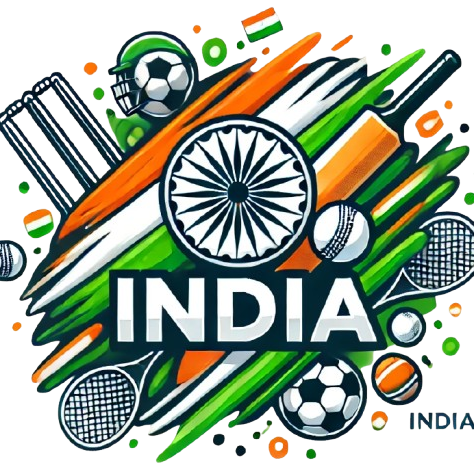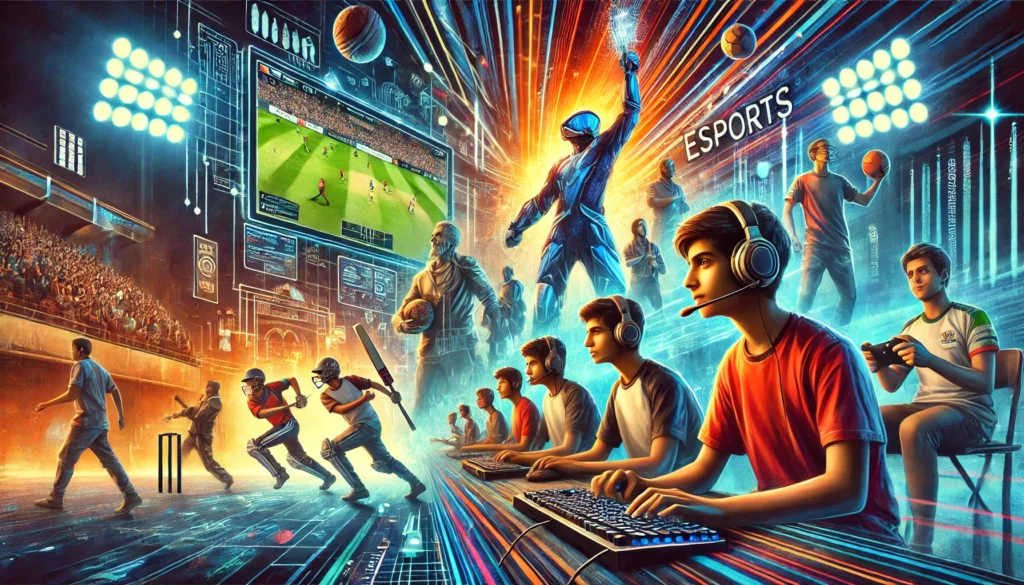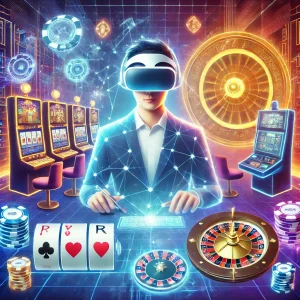In recent years, esports has experienced a meteoric rise in popularity among Indian youth, challenging the dominance of traditional sports like cricket, football, and badminton. The digital nature of esports, combined with the widespread availability of affordable smartphones and high-speed internet, has opened up a new world of competitive gaming to millions of young Indians. Unlike traditional sports that require physical space and infrastructure, esports can be played anywhere, allowing players to compete from their homes, local cafes, or even during commutes. This accessibility has been a key factor in the shift toward esports, making it easier for young people to explore their passion for gaming and connect with others who share similar interests. The rise of esports has also been fueled by a growing ecosystem of online platforms, tournaments, and professional gaming leagues, creating opportunities for players to turn their hobby into a potential career. As a result, esports has not only redefined the concept of competitive sports for Indian youth but has also carved out a significant place for itself in the broader cultural landscape of the country.
The Rise of Esports in India: A New Era of Competition
The rise of esports in India marks a significant shift in the way young people engage with sports and entertainment. This change is driven by various factors, including the growth of online gaming communities, the influence of streaming platforms, and the professionalization of competitive gaming. Together, these elements have contributed to the emergence of a vibrant esports scene that appeals to a tech-savvy generation.
Growth of Online Gaming Communities
One of the key drivers of the esports boom in India is the emergence of online gaming communities. Platforms like Discord, Reddit, and specialized gaming forums have provided a space where gamers can connect, share strategies, and participate in discussions about their favorite games. These communities have become a breeding ground for competitive spirit, allowing players to challenge each other and organize grassroots tournaments. As the popularity of these communities grew, so did the desire for more structured competitions, leading to the rise of larger esports tournaments and leagues.
The sense of belonging that comes with being part of a gaming community has made esports especially attractive to young people. It offers a space where they can find like-minded peers, learn from each other, and celebrate their achievements in a supportive environment. This sense of community has been crucial in fostering the growth of esports in India, as it provides a foundation for players to build their skills and pursue their passion for gaming.
Role of Streaming Platforms and Influencers
Streaming platforms like YouTube and Twitch have played a transformative role in the rise of esports in India. Indian gaming influencers and content creators have amassed millions of followers by streaming their gameplay, offering tutorials, and hosting interactive sessions with fans. These streams allow viewers to watch their favorite players in action, learn new strategies, and get a behind-the-scenes look at the world of competitive gaming. The popularity of gaming influencers has helped bring esports into the mainstream, making it a legitimate form of entertainment for both players and spectators.
The interactive nature of streaming platforms allows fans to engage with their favorite gamers in real time, creating a direct connection between players and their audience. This dynamic has helped build a sense of loyalty and excitement around esports, with fans cheering for their favorite players just as they would for a cricket or football star. As a result, streaming has become a powerful tool for expanding the reach of esports and attracting new fans, making it a critical component of the industry’s growth in India.
The Shift from Recreational Gaming to Professional Esports
What was once considered a recreational hobby has now transformed into a serious career path for many young Indians. The rise of professional esports teams, sponsored tournaments, and prize pools that can reach into the millions has created opportunities for talented players to make a living through gaming. This shift has been supported by investments from major gaming companies, as well as endorsements from brands eager to tap into the growing esports market.
Professionalization has brought with it a greater emphasis on skill development, with players dedicating hours to honing their craft, analyzing gameplay, and developing team strategies. Esports academies and training programs have emerged in India, offering aspiring gamers the chance to learn from seasoned professionals and compete at the highest levels. As a result, the competitive landscape of Indian esports has become more structured, attracting both players who dream of going pro and audiences eager to watch high-stakes matches.
Why Indian Youth Prefer Esports Over Traditional Sports
Esports has captured the imagination of Indian youth, offering a new kind of excitement and opportunity that traditional sports often struggle to match. One of the primary reasons for this preference is accessibility. Traditional sports often require access to specific facilities, coaches, and equipment, which may not be available to everyone, especially in remote areas. In contrast, esports requires little more than a smartphone or a computer and a stable internet connection, making it easier for a broader range of young people to participate.
The potential for earning through esports is another major draw. With opportunities to win cash prizes in tournaments, gain sponsorships, and earn through streaming, many young players see esports as a viable career path. This is particularly appealing in a country where conventional career options can sometimes feel limited, offering a chance to turn passion into profession. For some, the dream of becoming the next big esports star is as enticing as the idea of playing cricket for the Indian national team.
Additionally, esports offers a sense of global connectivity that traditional sports sometimes lack. Players can compete with opponents from around the world, participate in international tournaments, and make friends across different cultures. This global aspect of esports creates a feeling of being part of a larger community, where geographical boundaries matter less. This appeals to a generation that values global engagement and is accustomed to connecting through digital platforms.
The community-driven aspect of esports also plays a significant role. The ability to join online forums, participate in virtual events, and follow popular streamers has created a sense of belonging that is often missing in traditional sports. This sense of community, combined with the excitement of fast-paced gameplay and the potential for professional recognition, makes esports a compelling choice for Indian youth.
Top 5 Popular Esports Games Among Indian Youth
The Indian esports scene is dominated by a few key games that have become household names among the youth. These games offer a mix of competitive gameplay, accessibility, and community engagement, making them favorites for aspiring gamers. Here are the top five esports games that have captured the attention of young players in India:
- PUBG Mobile / BGMI
PlayerUnknown’s Battlegrounds (PUBG) Mobile, now rebranded as Battlegrounds Mobile India (BGMI), has been a major driver of the esports boom in India. Its popularity surged due to its easy accessibility on mobile devices and its engaging battle royale format. PUBG Mobile tournaments have attracted large audiences, and many players have gained fame through streaming their gameplay. - Valorant
Valorant, a tactical shooter developed by Riot Games, has quickly gained a foothold in India’s esports landscape. Its emphasis on teamwork, strategy, and skill-based gameplay has made it a favorite among PC gamers. Indian teams have started making their mark in international Valorant tournaments, bringing attention to the country’s growing competitive scene. - Free Fire
Free Fire, developed by Garena, is another mobile battle royale game that has a massive following in India. It is particularly popular in regions where access to high-end smartphones is limited, as the game is optimized for lower-spec devices. Free Fire’s community tournaments and frequent updates keep players engaged, making it a staple in India’s mobile gaming community. - Call of Duty: Mobile
Call of Duty: Mobile offers a mix of battle royale and multiplayer modes, attracting fans of both styles of gameplay. Its fast-paced action and polished graphics have helped it carve out a space in the Indian esports market. The game’s regular updates and events keep the community active, while competitive tournaments provide opportunities for players to showcase their skills. - Dota 2
Dota 2, a multiplayer online battle arena (MOBA) game, has a dedicated following in India, particularly among PC gamers. While it may not have the mass appeal of mobile games, Dota 2 remains a staple in the competitive gaming scene, with Indian players participating in regional and international tournaments. The game’s complexity and strategic depth make it a favorite among those who enjoy a more challenging competitive experience.
These games have become the cornerstone of India’s esports scene, each offering a unique experience that appeals to different segments of the gaming community. Their popularity highlights the diverse interests of Indian youth and the potential of esports to cater to a wide range of preferences.
Challenges Faced by Traditional Sports in Retaining Young Audiences
Traditional sports in India face a number of challenges in retaining the interest of younger audiences, who are increasingly drawn to the excitement and accessibility of esports. One of the biggest challenges is the competition from digital platforms that provide instant access to a wide array of gaming content. Unlike traditional sports, which require players to go to specific venues for practice and matches, esports can be accessed from anywhere with an internet connection, making it more convenient for young people.
Competition from Digital Platforms
The rise of streaming services and social media platforms has shifted the way young people consume entertainment, and sports are no exception. Esports tournaments are often broadcasted live on platforms like YouTube, Twitch, and Facebook, offering a dynamic viewing experience with real-time interactions. Traditional sports, on the other hand, often struggle to match this level of digital engagement, particularly among younger audiences who prefer the interactivity of online platforms.
Changing Preferences and Entertainment Consumption
The preferences of Indian youth have shifted towards forms of entertainment that offer quick rewards and social connectivity. Esports games, with their fast-paced gameplay and multiplayer modes, cater to this desire for instant gratification. Traditional sports, which often require years of practice to reach competitive levels, can seem less appealing in comparison. The cultural shift towards valuing digital skills has also made esports a more relevant pursuit for many young people, aligning with their interests and aspirations.
The Need for Adaptation and Innovation in Traditional Sports
To regain the interest of younger audiences, traditional sports need to adapt to the digital age by embracing new technologies and finding ways to integrate with online platforms. This could include live streaming of local sports events, creating engaging digital content, and offering interactive experiences that appeal to younger fans. Initiatives that combine traditional sports with technology, such as virtual training programs and fitness apps, can help bridge the gap between the physical and digital worlds, making traditional sports more relevant to today’s youth.
These challenges highlight the need for traditional sports to evolve and adapt in order to remain competitive in a world where digital entertainment is increasingly dominant. By embracing change, traditional sports can find new ways to connect with the next generation of sports enthusiasts.
Building a Balanced Sports Culture: Embracing Both Esports and Traditional Sports
As esports continues to rise in popularity, it is essential to build a balanced sports culture that values both digital and physical forms of competition. Rather than viewing esports and traditional sports as competitors, there is an opportunity to create an environment where both can thrive together. This involves recognizing the unique strengths of each and finding ways to integrate them into the lives of young people.
One approach could be to promote the physical and mental benefits of traditional sports alongside the cognitive skills developed through esports. Schools and communities can encourage participation in both, ensuring that young people have access to diverse opportunities for physical activity and digital engagement. This balanced approach can help foster a well-rounded sports culture that respects the value of teamwork, discipline, and competition in all its forms.
By supporting both esports and traditional sports, India can create a more inclusive sporting environment that meets the interests of today’s youth while preserving the rich heritage of traditional athletic pursuits. This harmony between the digital and physical worlds can pave the way for a brighter future for sports in India, where every young person can find a path that suits their passion and skills.



